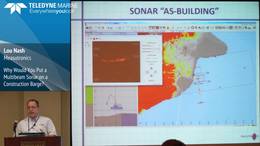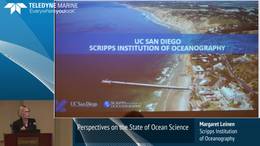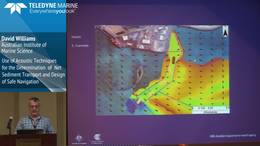Hydroacoustics in the USGS - Twenty-five years of Innovation
Acoustic instruments and methods for streamflow measurements first began to be integrated into the USGS streamgaging program in 1992, shortly after the TRDI Broadband Acoustic Doppler Current Profiler (ADCP) was released. Although these instruments were adopted especially on large rivers, the usage of ADCPs dramatically increased with the introduction of the Rio Grande ADCPs in 1997. Since then, that trend has continued, such that 97% of all non-wading discharge measurements are made with ADCPs. In 2002, the USGS began working with SonTek to adapt the Acoustic Doppler Velocimeter (ADV) – a lab instrument – for field applications and discharge measurements. In 2016, 84% of all discharge measurements were made with an acoustic instrument, corresponding to 68,800 discharge measurements.
The implementation and adaptation of hydroacoustic instruments and methods was successful for a number of reasons. Firstly, the USGS, Office of Surface Water (OSW) and the Hydroacoustics Work Group (HaWG) have worked cooperatively with manufacturers to see that changes were made to the instruments and software that minimize bias, improve efficiencies, and minimize user errors. Secondly, OSW and the HaWG have emphasized comprehensive and timely training of hydrographers. Thirdly, OSW has worked diligently to explore better methods, better software, and new applications for acoustic methods. As examples of the latter, we have developed and refined the discharge computation methods and software (QRev software) and developed the Velocity Mapping Toolbox. We are now working on improving methods for data exchange and interoperability and in developing operational tools for estimating discharge measurement uncertainty. Lastly, OSW and the HaWG have placed a heavy emphasis on field support by responding to telephone and email requests for assistance, sometime involving deployment of OSW personnel within 24 hours of the request.
Presentation by: Acoustic instruments and methods for streamflow measurements first began to be integrated into the USGS streamgaging program in 1992, shortly after the TRDI Broadband Acoustic Doppler Current Profiler (ADCP) was released. Although these instruments were adopted especially on large rivers, the usage of ADCPs dramatically increased with the introduction of the Rio Grande ADCPs in 1997. Since then, that trend has continued, such that 97% of all non-wading discharge measurements are made with ADCPs. In 2002, the USGS began working with SonTek to adapt the Acoustic Doppler Velocimeter (ADV) – a lab instrument – for field applications and discharge measurements. In 2016, 84% of all discharge measurements were made with an acoustic instrument, corresponding to 68,800 discharge measurements.
The implementation and adaptation of hydroacoustic instruments and methods was successful for a number of reasons. Firstly, the USGS, Office of Surface Water (OSW) and the Hydroacoustics Work Group (HaWG) have worked cooperatively with manufacturers to see that changes were made to the instruments and software that minimize bias, improve efficiencies, and minimize user errors. Secondly, OSW and the HaWG have emphasized comprehensive and timely training of hydrographers. Thirdly, OSW has worked diligently to explore better methods, better software, and new applications for acoustic methods. As examples of the latter, we have developed and refined the discharge computation methods and software (QRev software) and developed the Velocity Mapping Toolbox. We are now working on improving methods for data exchange and interoperability and in developing operational tools for estimating discharge measurement uncertainty. Lastly, OSW and the HaWG have placed a heavy emphasis on field support by responding to telephone and email requests for assistance, sometime involving deployment of OSW personnel within 24 hours of the request.
Presentation by: Kevin Oberg, USGS
The implementation and adaptation of hydroacoustic instruments and methods was successful for a number of reasons. Firstly, the USGS, Office of Surface Water (OSW) and the Hydroacoustics Work Group (HaWG) have worked cooperatively with manufacturers to see that changes were made to the instruments and software that minimize bias, improve efficiencies, and minimize user errors. Secondly, OSW and the HaWG have emphasized comprehensive and timely training of hydrographers. Thirdly, OSW has worked diligently to explore better methods, better software, and new applications for acoustic methods. As examples of the latter, we have developed and refined the discharge computation methods and software (QRev software) and developed the Velocity Mapping Toolbox. We are now working on improving methods for data exchange and interoperability and in developing operational tools for estimating discharge measurement uncertainty. Lastly, OSW and the HaWG have placed a heavy emphasis on field support by responding to telephone and email requests for assistance, sometime involving deployment of OSW personnel within 24 hours of the request.
Presentation by: Acoustic instruments and methods for streamflow measurements first began to be integrated into the USGS streamgaging program in 1992, shortly after the TRDI Broadband Acoustic Doppler Current Profiler (ADCP) was released. Although these instruments were adopted especially on large rivers, the usage of ADCPs dramatically increased with the introduction of the Rio Grande ADCPs in 1997. Since then, that trend has continued, such that 97% of all non-wading discharge measurements are made with ADCPs. In 2002, the USGS began working with SonTek to adapt the Acoustic Doppler Velocimeter (ADV) – a lab instrument – for field applications and discharge measurements. In 2016, 84% of all discharge measurements were made with an acoustic instrument, corresponding to 68,800 discharge measurements.
The implementation and adaptation of hydroacoustic instruments and methods was successful for a number of reasons. Firstly, the USGS, Office of Surface Water (OSW) and the Hydroacoustics Work Group (HaWG) have worked cooperatively with manufacturers to see that changes were made to the instruments and software that minimize bias, improve efficiencies, and minimize user errors. Secondly, OSW and the HaWG have emphasized comprehensive and timely training of hydrographers. Thirdly, OSW has worked diligently to explore better methods, better software, and new applications for acoustic methods. As examples of the latter, we have developed and refined the discharge computation methods and software (QRev software) and developed the Velocity Mapping Toolbox. We are now working on improving methods for data exchange and interoperability and in developing operational tools for estimating discharge measurement uncertainty. Lastly, OSW and the HaWG have placed a heavy emphasis on field support by responding to telephone and email requests for assistance, sometime involving deployment of OSW personnel within 24 hours of the request.
Presentation by: Kevin Oberg, USGS






